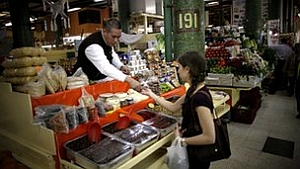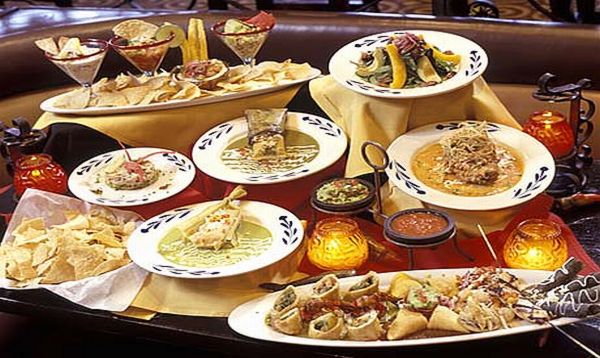Mexico City, Mexico - Delicious home-made corn tortillas filled with chilli sauce and grasshoppers as a starter, roasted iguana for the main course and a glass of agave liquor favored with worms to chase it all down. You would rarely see that on the menu of the thousands of Mexican eateries around the world. Yet they are all dishes easily found in the markets and restaurants of Mexico.
For decades, Mexican cooking has been associated with cuisine cooked in the areas bordering the US, the home of "Tex-Mex" food. But a new wave of chefs are determined to show the world real Mexican food - one that hasn't yet made it onto menus in New York, Sydney, or London.
"Unfortunately, the Mexican food served abroad is not at all like ours. There is a misperception that Tex-Mex food - hard shell tacos, burritos, chilli con carne - is part of our daily diet," says Ricardo Munoz Zurita, a well-known chef and owner of the Azul Condesa restaurant in Mexico City.
"Perhaps Mexican chefs don't know how to export their food as well as French, Spanish, or Italian cooks," he tells the BBC.
The United Nations Educational, Scientific and Cultural Organization (Unesco) recognized traditional Mexican cuisine as an example of Intangible Cultural Heritage in 2010, helping raise its profile.
Even US First Lady Michelle Obama who admits to being a big fan of tamales - corn dough rolls often filled with meat - recently launched a campaign promoting healthier Mexican products such as beans.
But changing the outside world's view of the country's food will take some time, according to Mr Munoz Zurita.
Restaurants offering pre-Hispanic recipes from the era before the Spanish arrived five centuries ago, are booming in Mexico City but have not been so successful abroad.
"Our daily diet is based on beans, corn, and chile. Three ingredients you can find in almost every authentic national dish," says chef Enrique Olvera, owner of Mexico City's Pujol, which was included on the latest San Pellegrino list of the finest restaurants in the world.
"The chile is part of our culture," Mr Olvera says, surrounded by chipotle, pasilla, and habanero chiles at Mexico City's San Juan market.
 |
| The San Juan Market is loaded with ingredients not found in Tex-Mex recipes |
This market attracts chefs and gourmands, drawn by ingredients such as ant eggs, chocolate with cinnamon and freshly ground coffee from the states of Chiapas and Veracruz in the south and east of the country.
But it's not only the ingredients contributing to Mexican cuisine's special status.
"Traditional Mexican cuisine is a cultural and comprehensive model comprised of farming, ritual practises, age-old skills, culinary techniques, and ancestral community customs and manners," according to Unesco.
Some cooking techniques were inherited from the Aztecs and indigenous communities by the Spanish conquerors, who then combined them with European methods.
The use of the milpa farming process (rotating swidden fields of corn and other crops) is still common in many parts of the country. Mexicans still use mortars made of volcanic stone to grind avocados to prepare guacamole, just as their ancestors did millennia ago.
Last year, the BBC's show Top Gear sparked complaints when it joked of the stereotype of the lazy Mexican, and compared the country's food to "refried sick." Mexicans were deeply offended.
Locals say a walk around any Mexican town would dispel any such attitude. Street vendors serve tacos with fresh cheese, grilled vegetables, and marinated meats served with fruits like pineapple. They also sell all manner of fresh juices. Chefs like Mr Munoz Zurita and Mr Olvera boast of the richness of Mexican products and the varied cooking techniques that are used.
But this traditional Mexican diet has long been under threat from a more modern Western-style one, with calorific junk food and sugar-laden fizzy drinks.
"It was when we stopped eating traditional Mexican food that obesity started to grow," the National Association of Nutritionists says.
It is an opinion that is taken seriously in Mexico, the second most overweight nation in the world. Only the US has higher levels of obesity.
According to the Organization for Economic Co-operation and Development (OECD), seven out of 10 Mexican adults are overweight, and nearly three out of 10 are obese.
According to a study by the market research firm Euromonitor, Mexicans are among the world's biggest consumers of soft drinks. Obesity related diseases like diabetes already account for 15% of deaths in the country every year.
According to Mexico's Health Ministry, obesity has become one of Mexican economy's heaviest burdens. The government is investing more than 1.2% of the country's gross domestic product every year to tackle obesity and its complications.
By 2017 those costs, and the associated loss of labor productivity, will rise to $14 billion if the epidemic is not stopped, the government warns.
"Our diet has always been rich in vegetables and unsaturated fats and actually, Mexican indigenous communities that continue to base their diet on tortillas and salsas are not suffering from weight problems," says Mr Munoz.
With so many Mexicans now facing Western-style health issues, the solution might mean going back to the recipes of their ancestors.


